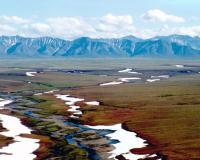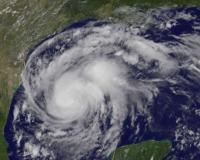
Vibrant Environment
All | Biodiversity | Climate Change and Sustainability | Environmental Justice | Governance and Rule of Law | Land Use and Natural Resources | Oceans and Coasts | Pollution Control

Some say leftovers are the best part of Thanksgiving. While that may be true, the rest of the year, there are ample missed opportunities to donate surplus prepared foods from institutions and restaurants. Realizing these opportunities is an important way to waste less food and feed more people, because up to 40% of food (along with the water, energy, and land used in production) goes to waste every year in the United States. At the same time, over 13% of Americans—one in eight—experience food insecurity.

Houston’s 160-acre Buffalo Bayou Park was designed to flood. The park is lined with native vegetation and landscaped to channel runoff and maximize floodwater transport capacity. Dog-walkers, joggers, bikers, and picnickers frequent the park, which also serves as habitat for native plant and animal species and has features that help filter pollutants from stormwater runoff that would otherwise flow directly into the waterway.

Many of the provisions in the tax legislation being considered by Congress this month (H.R. 1 “The Tax Cuts and Jobs Act” and related Senate legislation) as part of the Budget Reconciliation process are getting substantial attention: the reduction in corporate tax rates, elimination of the estate tax, consolidation of individual income tax brackets, elimination of medical and state and local tax deductions, and modification of the mortgage interest deduction. However, one key matter in the package is only now beginning to receive notable public attention: the long and hard-fought legislation to open the Coastal Plain of the Arctic National Wildlife Refuge (Arctic Refuge) to oil and gas leasing and development.

International illegal wildlife trade (IWT) threatens global biodiversity, imperils certain charismatic species, and fuels organized crime. Wildlife trafficking is the world’s fourth most lucrative crime, after only the trafficking of drugs, humans, and arms. Approximately 350 million plants and animals are sold on the black market every year, with an estimated value of between US $7 billion and $23 billion.

On October 18th, the Environmental Law Institute hosted its annual ELI Award Dinner. Affectionately known as the “environmental law prom,” over 650 of the best and brightest environmental professionals from across the country descended upon Washington, D.C., to connect with colleagues and honor this year’s winner of the ELI Environmental Achievement Award.

EPA Administrator Scott Pruitt’s “back to basics” agenda for the Agency suggests a renewed focus on the fundamentals of environmental protection. But according to a new article in the November 2017 issue of the Environmental Law Reporter, “Pruitt is not preserving the ‘basics’ of our environmental protection system, but deconstructing them.”

Electronic waste, or e-waste, is the fastest-growing segment of the municipal waste stream. Nearly 100% is recyclable, and valuable materials like plastics, metals, and glass can be recovered. E-waste also can contain toxic materials, like lead, mercury, and arsenic. Worldwide, up to 50 million tons of e-waste is expected to be dumped in 2017. Yet, in the United States, less than 30 percent is recycled.

As reported in the Environmental Law Reporter’s Weekly Update this month, two cases involving the controversial Dakota Access Pipeline have been decided in the courts.
Chief among those cases was Standing Rock Sioux Tribe v. Dakota Access. In that case, a district court held that the Dakota Access pipeline could continue to operate while the U.S. Army Corps of Engineers corrects deficiencies in its environmental assessment for the project.

On September 4-6, the Organization of American States (OAS), UN Environment, the Global Judicial Institute on the Environment (GJIE), the World Commission on Environmental Law (WCEL), the Supreme Court of Chile, and other partners convened the 2nd Inter-American Congress on the Environmental Rule of Law in Santiago, Chile.

While EPA under Administrator Scott Pruitt seeks to drastically reduce the social cost of carbon (SCC), insurers already know that 2017 delivered the most expensive Atlantic hurricane season ever for insurance companies. Beyond this year, since the 1980s, the annual average losses to insurers have risen, increasing over the last decade from $10 billion to about $50 billion. “Insurers are rightfully worried that, in the long term, climate change could devastate their industry,” reported the Los Angeles Times. While Texas, Florida, and Puerto Rico flood, EPA recalculates, and insurance companies add up their costs.